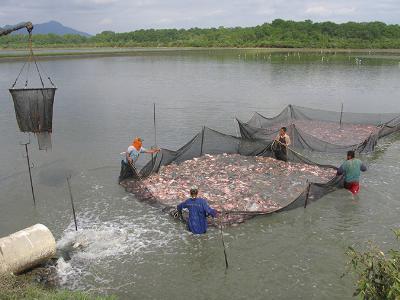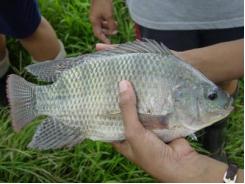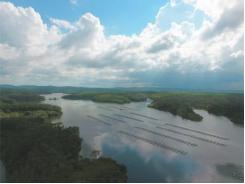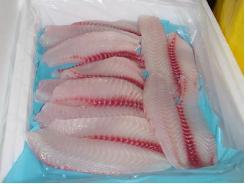Addressing safety in Latin Americas tilapia supply chain

Successful farmers adopt conservative practices to avoid losses caused by biosecurity problems
Significant resources and time to properly raise a quality crop of tilapia are already invested when the fish are harvested, and proper harvesting procedures must be followed to preserve product quality.
With worldwide, increasingly strict export standards for seafood products – in particular those standards developed to improve food safety – the capability of different countries to analyze for “contaminants” or “residues” at the level of precision required by the importing countries is often not available or not enforced as required.
Contaminants and residues include antibiotics, pesticides, and heavy metals. Further, the capability of each country to apply HACCP (Hazard Analysis Critical Control Points) concepts in the production systems, as a precursor for addressing much needed traceability, may also be insufficient in some instances. While not having adequate capacity to address the issue, some countries are still facing difficulties in adopting coordinated standard for aquaculture products, whether for export or for domestic consumption.
Farmer organizations and consumer associations, as well as institutional buyers such as the supermarket chains and other key stakeholder groups, will continue to exert increasing influence on policies and regulations and are also actively promoting the adoption of standards by the aquaculture sector.

Tilapia are widely farmed in Latin America using earthen pond culture (left), floating cage (center) or raceway/tank technologies (right), and various countries in the region are the major suppliers of fresh fillets to the U.S. market.
Production operations at the farm
The production process begins during pond preparation for the next cycle. Depending on the season (dry or wet in the tropical and sub-tropical regions), the pond bottom is plowed and dried. Various lime products are added to help oxidize organic matter and also to eliminate undesirable organisms like competitors and pathogens.
The pond is then filled with water, filtered through each inlet gate’s fine screen so predators and pathogenic vectors are excluded and kept out of the pond. The newly filled pond is then stocked with young fish at the desired stocking rate.

Lime applications (white powder) in drained pond to oxidize the organic matter present in the soil from the previous cycle – note depressions on pond bottom built by male tilapia and used as nests (left). Concrete inlet gates with wooden boards to control water flow, and screens to prevent the entrance to the ponds of unwanted organisms like wild fish that can be pathogen carriers and become competitors in the growout pond environment (right).
In semi-intensive operations in the most successful Latin American tilapia- producing countries, the ponds are stocked between seven and 10 days after filling, with previously selected, healthy and strong fish, following all of the biosecurity protocols and according to the planned stocking strategy for the production cycle.
In the nursery stage, young tilapia (0.85 to 1.5 grams) are stocked and the average survival rate after a culture period of 45 days is approximately 70 percent. In the pre-growth phase, fish are placed in the ponds at an approximate weight of 28g, and the average survival rate after an average culture period of 100 days is between 85 and 90 percent.
In the grow-out phase, 250g fish are stocked at a density of three to five tilapia per square meter and the average survival rate after approximately 150 days of culture is 85 percent. Mechanical aeration is often used by many producers in all production phases to improve water quality.

Only healthy seedstock, with proper health certificates when possible, should be stocked.
Although these stocking densities may not seem highly productive, many successful farmers have adopted these conservative practices to avoid losses caused by biosecurity problems. Their experiences, combined with some effective sanitary programs implemented by government offices (federal and state) in the last several years, have improved productions statistics in the Latin American region. These programs are focused on the supervision of good management practices, verified through periodical visits to the facilities, and by on-site sample analyses carried out by qualified personnel.
Some recommendations to the tilapia farmers – included in the safe management protocols described in the programs established by the regulatory agencies – include the following:

Use of the best feeds possible is an integral and critical part of the tilapia farming process.
1 – use offspring with health certificates or with diagnosis that support their overall quality;
2 – maintain an adequate biomass in the production unit;
3 – separate the fish by size classes;
4 – keep proper records of water quality parameters (biological, chemical and physical);
5 – provide adequate maintenance to the equipment (generators, aerators, others);
6 – provide technical training to the personnel in charge of production;
7 – keep preventive protocols current at all times;
8 – be ready to implement emergency protocols.
After the visits, the farmers receive a report describing the presence or absence of bacteria, parasites or any other pathogen that might affect their production goals. In addition, the report includes results of water quality analyses to certify that the production units are free of any undesirable compounds or organisms – pesticides, heavy metals, or pathogenic fecal or total coliforms – which guarantee that the production is safe for human consumption and it can be commercialized in local or foreign markets.
Feed manufacturing and safety
Feed manufacturing must be considered an integral part of the food production chain and therefore subject to quality and safety assurance. The feed industry is ultimately responsible for the quality and safety of the feed it produces. National authorities should provide guidance to manufacturers through codes of practice and standards. In this regard, continued dialogue among producers of feed or feed ingredients, aquaculture producers, processors and the government is of crucial importance
To promote food safety in aquafeed for tilapia consumption, raw materials must be purchased from known suppliers with records of low risk. Prior to being processed, raw materials should be thoroughly checked against specifications and for purity by certified laboratories. Feed production processes should be in full compliance with good manufacturing practices and HACCP guidelines. Certification from a major, established global scheme is highly desirable and recommended.
Tilapia processing plants
Today, even at some modern and well-designed tilapia-processing plants in the region, some operational details still do not comply with standard measures that make the workplace safe for workers and final products. One classic example is plant floors built with channels or ditches designed to collect liquid and solid waste. Workers could accidentally step into the ditches and be hurt. They also interfere with the secure transport of product carts from one stage of the process to the next. A better alternative is solid flooring with a slope that allows water and solids to concentrate on one side of the primary stage of the processing facility.
Some air-conditioned processing facilities lack ceilings, which causes temperature dispersion. Consequently, thermostats never shut off, causing unnecessary energy consumption and likely temperature variations. Constant room temperature in processing facilities is a critical issue in HACCP programs, for the product as well as the workers.
Most modern fish-processing plants have adopted effective ways to transport product in process from one station to another that avoid contamination from metal particles and the grease used to lubricate the rails and chains. Conveyor belts and rollers can be a viable alternative. Ice handling is another issue that merits attention.
In some cases, farms and processors use the same ice source. The practice is not very safe from a biosecurity point of view, since the possibility of cross-contamination is very high. The solutions are to use separate icemakers, one for each working stage, or separate storage units to hold the ice produced by one icemaker.

Processing of fresh tilapia fillets for the U.S. market at a major Latin American producer (right), with a close view of the final, high-quality product.
Perspectives
To improve tilapia farm production and achieve sustainable operations to guarantee the permanent furnishing of end products, primary producers, processors, and importers have to establish some conditions, to avoid biosecurity conflicts when the products are sold in local or foreign markets.
The farmer must comply with the following aspects to reduce the risk of disease outbreaks: good pond preparation, good quality seed selection, water quality management, feed management, health monitoring (biosecurity), pond bottom monitoring, disease management, harvest and post-harvest practices, record maintenance (traceability) and environmental awareness.
The processor, on the other hand, must verify each and every stage involved in the value adding process after it receives the raw material to be transformed (including receiving, cutting, packing, and shipping). Lack of coordination among the parties will create food safety issues for the consumer, which could lead to disease transmission or food poisoning.
The production of safe foods implies the adoption of methodologies that allow the identification and assessment of potential hazard due to contamination were the products are produced and consumed. Therefore, it is required that every link of the chain (from the production unit to the consumer’s table) controls and activates mechanisms to manage potential risk.
In successful production companies in the region, these practices have been adopted to serve the export markets, and the countries that receive the finished products (mostly fresh tilapia fillets). Through actual inspection visits, customers (purchasing agents) verify that GMP and HACCP protocols are in place, at least once or more times every year.
Cesar C. Alceste, M.Sc. - Consultant – Tilapia production, processing and marketing, Miami, Fla., USA
Related news
Tools

Phối trộn thức ăn chăn nuôi

Pha dung dịch thủy canh

Định mức cho tôm ăn

Phối trộn phân bón NPK

Xác định tỷ lệ tôm sống

Chuyển đổi đơn vị phân bón

Xác định công suất sục khí

Chuyển đổi đơn vị tôm

Tính diện tích nhà kính

Tính thể tích ao




 Successful production of Nile and blue tilapia fry
Successful production of Nile and blue tilapia fry  Adding value to tilapia to tap into U.S.…
Adding value to tilapia to tap into U.S.…